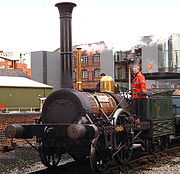
Planet (locomotive)
Encyclopedia

Planet was an early steam locomotive
Steam locomotive
A steam locomotive is a railway locomotive that produces its power through a steam engine. These locomotives are fueled by burning some combustible material, usually coal, wood or oil, to produce steam in a boiler, which drives the steam engine...
built in 1830 by Robert Stephenson and Company
Robert Stephenson and Company
Robert Stephenson and Company was a locomotive manufacturing company founded in 1823. It was the first company set up specifically to build railway engines.- Foundation and early success :...
for the Liverpool and Manchester Railway
Liverpool and Manchester Railway
The Liverpool and Manchester Railway was the world's first inter-city passenger railway in which all the trains were timetabled and were hauled for most of the distance solely by steam locomotives. The line opened on 15 September 1830 and ran between the cities of Liverpool and Manchester in North...
. The ninth locomotive built for the L&MR, it was Stephenson's next major design change after the Rocket. It was the first locomotive to employ inside cylinders
Cylinder (steam locomotive)
The cylinders of a steam locomotive are the components that convert the power stored in the steam into motion.Cylinders may be arranged in several different ways.-Early locomotives:...
, and subsequently the 2-2-0
2-2-0
Under the Whyte notation for the classification of steam locomotives, 2-2-0 represents the wheel arrangement of two leading wheels on one axle, two powered driving wheels on one axle, and no trailing wheels...
type became known as Planets. On 23 November 1830 No.9 Planet ran from Liverpool to Manchester in one hour. Six further of the type were ordered by the L&MR from Robert Stephenson & Co. Three more were supplied by Murray & Wood in Leeds, to whom Robert Stephenson & Co. had sent the drawings for their manufacture.. The Planet (from 1830) and the Patentee
Patentee locomotive
This was a revolutionary 2-2-2 steam locomotive type introduced by Robert Stephenson and Company in 1833, as an enlargement of their 2-2-0 Planet type...
(from 1833, also designed by Stephenson) were the first locomotive types to be built in large numbers..
Improvements
The Planet locomotives appear closer to subsequent types, and conversely look quite different from Rocket although only a year separated these two designs (Stephenson's NorthumbrianNorthumbrian (locomotive)
Northumbrian was an early steam locomotive built by Robert Stephenson in 1830 and used at the opening of the Liverpool and Manchester Railway. It was the last of Stephenson's 0-2-2 locomotives in the style of Rocket, but it introduced several innovations...
representing an intermediate evolutionary step).
Other improvements include:
- a steam dome to prevent water reaching the cylinders
- buffers and couplingsCouplingA coupling is a device used to connect two shafts together at their ends for the purpose of transmitting power. Couplings do not normally allow disconnection of shafts during operation, however there are torque limiting couplings which can slip or disconnect when some torque limit is exceeded.The...
in a position setting a new standard.
Replica
A modern working replica was built in 1992 by the Friends of the Museum of Science and Industry (MOSI) in ManchesterManchester
Manchester is a city and metropolitan borough in Greater Manchester, England. According to the Office for National Statistics, the 2010 mid-year population estimate for Manchester was 498,800. Manchester lies within one of the UK's largest metropolitan areas, the metropolitan county of Greater...
, and is operated by volunteers every summer to provide rides for visitors.
Later engines named Planet
LMS Royal Scot ClassLMS Royal Scot Class
The London, Midland and Scottish Railway Royal Scot Class is a class of 4-6-0 express passenger locomotive introduced in 1927. Originally having parallel boilers, all members were later rebuilt with tapered type 2A boilers, and were in effect two classes.-Background:Until the mid-1920s, the LMS...
4-6-0
4-6-0
Under the Whyte notation for the classification of steam locomotives, 4-6-0 represents the wheel arrangement of four leading wheels on two axles in a leading truck, six powered and coupled driving wheels on three axles, and no trailing wheels. This wheel arrangement became the second-most popular...
locomotive 6131 was originally named Planet when built in 1928 but was in 1936 renamed The Royal Warwickshire Regiment. In 1948, the name was applied to LMS Rebuilt Patriot Class
LMS Rebuilt Patriot Class
The London Midland and Scottish Railway , Rebuilt Patriot Class was a class of 4-6-0 steam locomotives. They were rebuilt from LMS Patriot Class locomotives over the period 1946-1949.The Patriot class were the fourth type of LMS 2A boilered 4-6-0,...
No. 45545.
External links
- "Planet Type 2-2-0" on VictorianWeb

